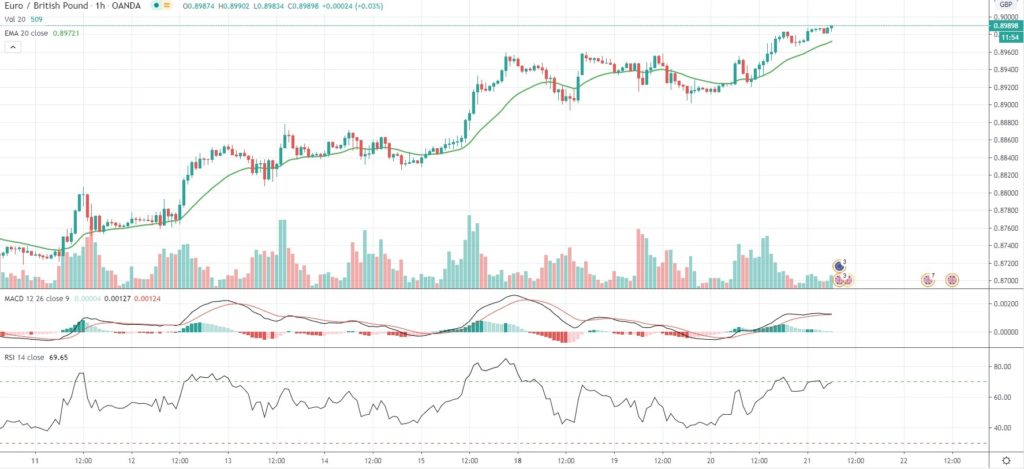EUR/GBP touched a fresh eight-week high during the early phase of the European session on Thursday, since weak UK inflation data fueled negative interest rate prospects, mounting pressure on the Sterling.
“The negative view we previously held for the kiwi on the back of a dovish Reserve Bank can now be extended to the pound and the BOE,” Terence Wu, Forex strategist at Singapore’s OCBC Bank, said.
“For now, with the soggy dollar protecting cable downside, we prefer to express this view through a higher euro/sterling.”
As of 6:44 GMT on Thursday EUR/GBP was gaining 0.20% to trade at 0.8988, after touching an intraday high of 0.8990, or a level not seen since March 27th (0.9093).
Meanwhile, annual consumer inflation in the Eurozone was reported to have slowed to 0.3% in April, final data released on Wednesday showed. It was a slight revision down from a preliminary estimate of 0.3%. Downward pressure came mostly from energy prices, which registered a 9.7% drop amid the COVID-19 pandemic and an oil price war between Saudi Arabia and Russia. In March, the general CPI rose 0.7% from a year ago.
Eurozone’s core CPI inflation decelerated to its lowest level since August 2019 in April, 0.9%, with the final estimate confirming the preliminary data. In March, the core CPI went up 1.0% year-on-year.
Market players now await another key string of macro data coming from the UK. Activity in United Kingdom’s sector of manufacturing probably contracted at a lesser rate in May, with the corresponding Purchasing Managers’ Index coming in at a reading of 35.0, according to the median forecast by experts. In April, the PMI was reported at a final 32.6, which pointed to the sharpest contraction in the sector since the survey was initiated in January 1992. The COVID-19 pandemic has caused the sub-indexes of new orders, exports and employment to drop at record rates.
At the same time, activity in United Kingdom’s sector of services probably shrank at a slower rate in May from a month ago, with the respective PMI coming in at a reading of 24.0, according to market expectations. In April, the Services PMI stood at 13.4, indicating the most severe contraction in the sector since the survey began in July 1996.
A larger-than-expected improvement in either of the gauges would certainly lend support to the Sterling. The IHS Markit/CIPS will release the preliminary data at 8:30 GMT.
Additional focus will be set on the manufacturing and services data from the Eurozone. German manufacturing Purchasing Managers’ Index probably pointed to a lesser contraction in May, with the preliminary index coming in at a reading of 40.0, according to market expectations. In April, the PMI was reported at a final 34.5, signaling the steepest contraction in factory activity since March 2009. The coronavirus pandemic and global measures to contain its spread have led to a record drop in production and new orders.
At the same time, activity in German services sector probably shrank at a slower rate in May from a month ago, with the preliminary PMI coming in at 26.0, according to market consensus. In April, the index stood at a final 16.2, indicating the deepest contraction on record. The preliminary data will be released at 7:30 GMT.
Manufacturing activity in the whole Euro region probably contracted at a slower rate in May from a month ago, with the preliminary Purchasing Managers’ Index rising to 38.0, according to expectations. In April, the gauge was reported at a final 33.4, pointing to the sharpest contraction in the sector since the survey was initiated in June 1997.
Activity in the Eurozone’s services sector is also seen contracting at a slower pace in May, with the preliminary PMI rising to a level of 25.0 from a final 12.0 in April. The preliminary data is due out at 8:00 GMT.
Bond Yield Spread
The spread between 2-year UK and 2-year German bond yields, which reflects the flow of funds in a short term, equaled 66.3 basis points (0.663%) as of 4:15 GMT on Thursday. It has remained close to the five-year low from May 20th.
Daily Pivot Levels (traditional method of calculation)
Central Pivot – 0.8955
R1 – 0.8999
R2 – 0.9026
R3 – 0.9069
R4 – 0.9113
S1 – 0.8928
S2 – 0.8885
S3 – 0.8857
S4 – 0.8830
EUR/GBP is about to face resistance at the round 0.9000 level and then, at the R2 pivot level of 0.9026. A break above may expose the high from March 27th (0.9093). Support may be expected at today’s low/20-period EMA (0.8972).






